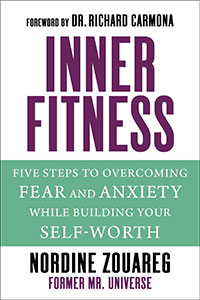By Nordine Zouareg | CONTRIBUTOR |
Why We Do What We Do When We are Afraid? Fear has many layers, to get to the core, one must peel them all, one by one.
Societies throughout human history have been driven by violence. As a wellness coach, I am particularly interested in the physical, mental, and emotional health of my clients. Lately, and in light of the recent riots at the U.S. Capitol, I’ve been (as I’m sure many of you are) asking myself why we do what we do when we are afraid. Why fear-driven anger leads us to commit violence? There are many theories about the underlying causes associated with violence so it would be difficult to identify its roots as they are many factors involved, age, race, socioeconomic, gender, background, and such.
Fear-Driven Anger

Fear will ultimately breed anger out of our human instinct for self-defense. When we feel threatened, we may initially fear potential harm to ourselves or our loved ones. However, in most cases, anger follows or even overrides fear. Negative emotions such as anxiety, depression, anger, and doubt can result from long and erroneous beliefs fed by our own story or a story we seem to connect with. When we seek and get the validation we are hooked, no matter how false the message. It becomes an unhealthy relationship between what we’re fed and our subconscious. We can say that what we hear or what we see is making us feel instant gratification, it feels good! Yes, I believe there was euphoria involved when people attacked the capitol, or even when a husband beats his wife.
Ironically, those fear-driven positive emotions are illusory, as long as they are void of facts and evidence, they remain dangerous to our wellbeing and the wellbeing of others around us. When we ask someone why they took part in a dangerous and violent riot, they often smile in anger and back their violence with righteous and invalidated claims. To them, they enjoyed inflicting pain in the name of patriotism or even the simple fact of belonging to a bigger cause.
I’m not saying, however, that anger always leads one to commit a crime. We know, that’s not the case. We all get angry from time to time, but most of us do not respond to it by committing a crime. Some of us jump, yell, and scream, while others may get drunk. We feel the pain, then it goes away. Jill Bolte Taylor, a brain scientist and best-selling author of A Stroke of Insight, explains in her book that when someone reacts to something in their environment, there’s a 90-second chemical process that takes place in the body; after that, any remaining emotional response is just the person choosing to stay in that emotional loop.
Something happens in the external world that triggers chemicals to flush through the body, which puts it on full alert. For those chemicals to flush out of the body, it takes less than 90 seconds. So, during that time you can watch and feel the process happening, you can feel it, and then you can watch it go away.
After that, if you continue to feel fear, anxiety, anger, etc., you can actively choose different thoughts from the ones that are re-creating the circuitry resulting in you experiencing this physiological response repeatedly.
How to Effectively Use the 90-second Loop

Surrender to the immediate feeling by allowing yourself to experience it. Acknowledge it without owning it; it’s going to happen anyway. However, now you know you have 90 seconds to divert your attention to a more positive and relaxing focus while your immediate physical response runs its course. You have 90 seconds to switch your thinking.
A powerful way that works for me is to take deep, slow breaths as I allow myself to connect to the present moment. But you can find your own diversion technique — do whatever you can to get through the emotion, count, step up and down or do pushups in 90 seconds. You can also use a mantra such as, “All is good, I’m fine!” Or simply sing one of your favorite songs, out loud or in your head.
Your thoughts are not you; don’t let them control your life.
| By Nordine Zouareg, Author of the book
InnerFitness |
 |
By Nordine Zouareg, Author of the book
InnerFitness
Five Steps to Overcoming Fear and Anxiety
While Building Your Self-Worth.’
Subscribe to get notifications about future articles.
About the Author: Nordine Zouareg – Contributor
Nordine Zouareg is the founder of Executive InnerFitness®, which for the past decade has helped thousands of overworked US Corporate Executives find work-life balance. As a former two-time Mr. Universe champion, an internationally acclaimed high-performance coach, fitness and wellness expert, author of the books Mind Over Body (Grand Central Publishing, 2007), and InnerFitness (SkyHorse Publishing, 2021), Nordine has made it his mission to provide effective and proven methods for maintaining both emotional and physical fitness. He has spent years understanding the unique pressures and stresses of working in high performance fields and has used his knowledge to help people tap into their ability for peak performance and ward off stress and emotional chaos. He draws on three decades of diverse experience in the fitness and wellness fields, including 10 years leading the revolutionary fitness program at Miraval Resort, the world-class destination spa in Tucson, Arizona.


